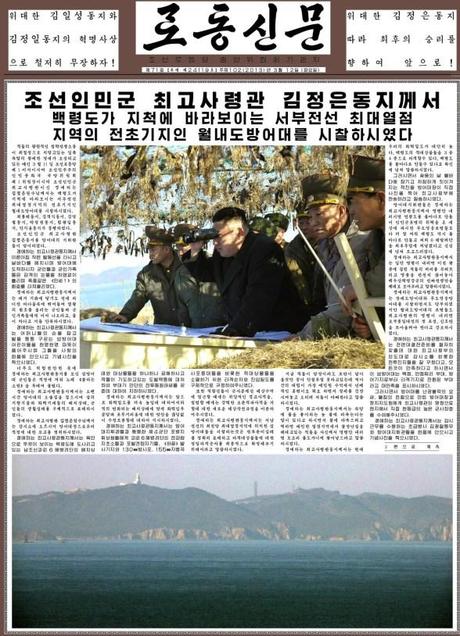
Front page of the 12 March 2013 edition of Rodong Sinmun, the daily newspaper of the Korean Workers’ Party
DPRK state media reported on 11 March (Monday) that Kim Jong Un (Kim Cho’ng-u’n) inspected a Korean People’s Army [KPA] long-range artillery unit, visited a fish farm and inspected an islet defense unit. KJU’s last reported public appearance was his visit to the Chongchun Sports Village in Mangyo’ngdae, Pyongyang. KJU’s first appearance was a field inspection of a long-range artillery unit subordinate to KPA Unit #641 described as having a “mission is to strike and wipe out the enemies on Paekryong Island.” Attending the inspection were VMar Choe Ryong Hae (Director of the KPA General Political Department), Gen. Kim Kyok Sik (Minister of the People’s Armed Forces), Gen. Kim Yong Chol (Chief of the Reconnaissance General Bureau and spokesman of the KPA Supreme Command), Lt. Gen. Pak Jong Chon (Staff member of the KPA Supreme Command), Maj. Gen. An Ji Yong and Rim Kwang Il.
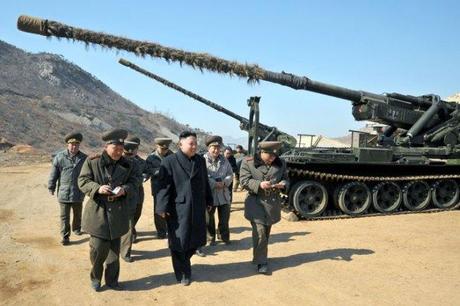
Kim Jong Un (2nd L) views a piece of long-range artillery piece during an inspection of a unit subordinate to the KPA Unit #641 (Photo: Rodong Sinmun)
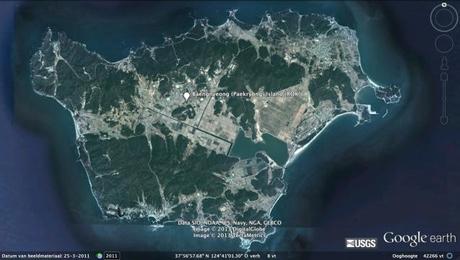
Paekryong (Baengnyeong) Island in the West (Yellow Sea) (Photo: Google image)
After his arrival at the unit Kim Jong Un presented an automatic rifle and a pair binoculars during a brief ceremony, then posed for commemorative photographs with the unit’s service members and officers. KJU was briefed by the unit commanders about the unit’s operations. According to KCNA, Kim Jong Un “highly praised the sub-unit for having made perfect combat preparations as required by the operational technological plan of the Supreme Command, grasped all enemy targets and waited for the issue of an order to fire.” He inspected the unit’s artillery pieces and “assigned to it the duty to blow up the headquarters of the puppet sixth marine brigade and its affiliated marine battalions through merciless firepower strikes if the enemies on Paekryong Island make a provocation.” KJU watched the unit’s training activities and “he praised them for being fully prepared to fire shells right now.” According to KCNA Kim Jong Un said “A modern war is an artillery war and the combat preparations of artillerymen is the one of the KPA” and “each day at present is little short of a real war state in the true sense of the word and for the artillerymen to become master cracks is a combat task which brooks no delay.” KJU also “ underscored the need to steadily study and round off new artillery war methods of Korean style in line with the improved arms and equipment of the unit and the changing operational scenarios of the enemies, meticulously organize and command artillery operations and combats and thus give fullest play to the might of artillery pieces.”
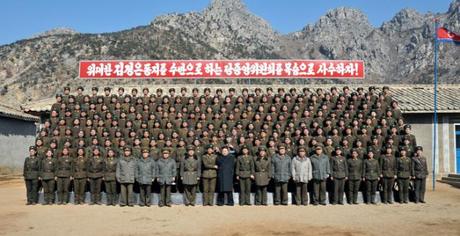
Kim Jong Un (front row, 12th L) poses for a commemorative photograph with service members and officers of the long-range artillery unit subordinate to KPA Unit #641 (Photo: Rodong Sinmun)
Kim Jong Un said that “he attaches importance to this artillery unit, he underlined the need to deal blows of justice at the enemies through unimaginably deadly strikes and wipe out the group of aggressors to the last man, if they recklessly provoke.” He toured education facilities and the unit’s quarters and he “expressed great satisfaction again over the fact that the commanding officers and soldiers of the units stationed in the western sector of the front have turned all the operation theatres into impregnable fortresses to defend the party, the revolution, the country and its people at the cost of their lives.” He said “the areas in the western sector of the front are the biggest hotspot where a war can break out right now due to the reckless provocations of the enemies for aggression” and “to maintain the maximum alert as required by a touch-and-go situation and make powerful retaliatory strikes at the enemies if they intrude into seas of the country even 0.001mm on which the DPRK’s sovereignty is exercised.”
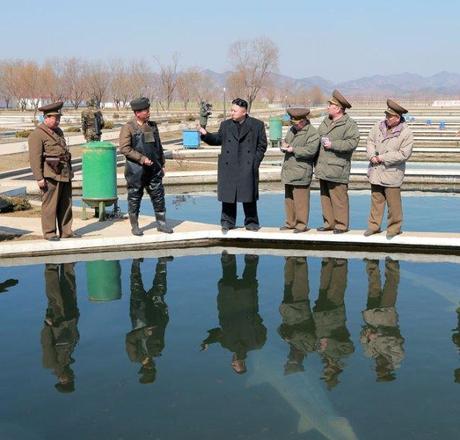
Kim Jong Un (4th R) views a fish breeding pool at the Ryongjong Fish Farm. Also seen in this image are VMar Choe Ryong Hae (3rd R), Gen. Kim Kyok Sik (2nd R) and Gen. Kim Yong Chol (R) (Photo: Rodong Sinmun)
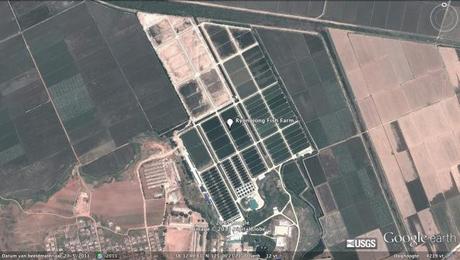
A view of Ryongjong Fish Farm in South Hwanghae Province, visited by Kim Jong Un on 11 March 2013. It was also visited by late leader Kim Jong Il on or around 21 November 2010, two days prior to KPA forces’ artillery shelling of Yo’np’yo’ng Island on 23 November 2010 (Photo: Google image)
Kim Jong Un’s next visit was to the Ryongjong Fish Farm. The DPRK’s late supreme leader visited the fish farm prior to the artillery shelling of Yo’np’yo’ng Island by KPA forcs on 23 November 2010. KCNA reported that KJU “recollected the long and tiresome journeys made by Kim Jong Il, exerting devoted efforts to bring about a fresh turn in fish breeding as required by the new century, saying he could not forget November 21, 2010 when he visited there, accompanying the leader.” He toured a water temperature control facility and the fish farm’s indoor and outdoor breeding ponds. According to KCNA Kim Jong Un said, “What is important in fish breeding is to put fish farming on a scientific basis. This would make it possible to keep fish production going at a high rate.” He toured the water supply and the Ryongjon Fish Farm production facilities. KJU said, “people cannot substantially benefit from fish farms if the supply of food for fishes is not put on a par with fish production no matter how many modern ones are built.”
KCNA reported that “Seeing the letters displayed in the compound of the fish farm ‘Sturgeons go to sea while the DPRK advances into the world’, he told the officials to add the letters ‘Satellites enter space’. World-startling miracles are being worked in various parts of the country through a dynamic drive for breaking through the cutting edge under the wise leadership of our party, he added.”‘ KCNA also reported “Noting that the Ryongjong Fish Farm is crystal of Kim Jong Il’s love for people, he proposed erecting a monument to the undying leadership feats of Kim Jong Il and displaying his portrait in the compound of the farm to convey his loving care to posterity” and that KJU “told the officials and employees of the fish farm to play a pioneer’s role in translating the desire of Kim Jong Il to provide the people with more fish into reality.”
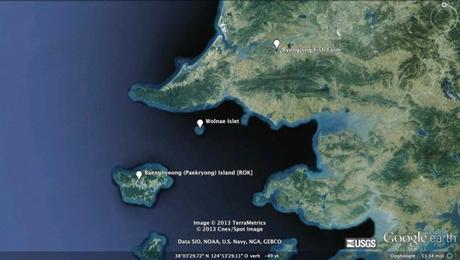
An overview of areas in the West (Yellow) Sea, near the North Limit Line (NLL) Kim Jong Un visited and discussed with senior military officials on 11 March 2013 (Photo: Google image)
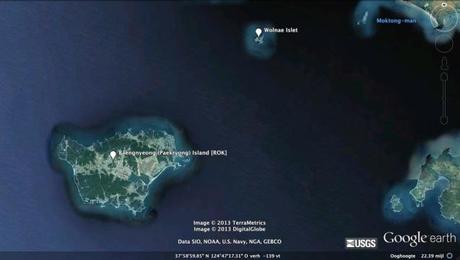
View of Wolnae Islet (DPRK) and Paekryong (Baengnyeong) Island (ROK) (Photo: Google image)

Kim Jong Un (3rd L) peers through binoculars at South Korea’s [ROK[ Paekryong (Baengnyeong) Island (R) from an observation post on Wolnae Islet on 11 March 2013. Also seen in attendance is Gen. Kim Yong Chol (2nd R), chief of the Reconnaissance General Bureau and spokesman of the KPA Supreme Command (Photos: Rodong Sinmun)
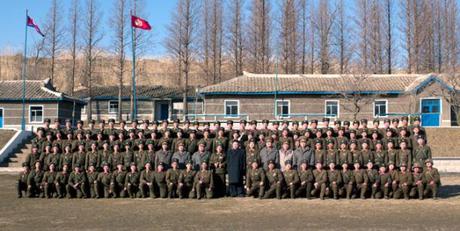
Kim Jong Un poses for commemorative photograph with service members and officers of the Wolnae Islet defense unit (Photo: Rodong Sinmun)

Kim Jong Un poses for a commemorative photograph with service members, officers and their family members during a field inspection of Wolnae Islet’s defense unit on 11 March 2013 (Photo: Rodong Sinmun)
Kim Jong Un’s final stop was a field inspection to an island defense unit on Wolnae Island, described as “an outpost in the biggest hotspot in the western sector of the front very near from Paekryong Island.” KJU was greeted by the children and spouses of service members and officers on the island defense detachment. KCNA reported that KJU “walked along the lane leading to the detachment and learned in detail about the terrains of the islet, deployment of firepower equipment and the soldiers’ living for hour.” KCNA also reported that:
He was briefed on the enemy’s situation from the commander of the detachment at the observation post.
He acquainted himself with the troop deployment and targets of the 6th marine brigade of the south Korean puppet army on Paekryong Island and praised the detachment for being fully ready to go into action in order to cope with the enemy’s attempt at provocations.
He underscored the need to keep increasing the density of fire and steadily modify and supplement the proposal for assignment of fire power duties and use of artillery pieces in order to cope with the enemy’s changed troop deployment.
He specified before the commanding officers of the detachment and the leading members of the artillery unit of the 4th Army Corps of the KPA who accompanied him the order of strike and density of fire for wiping out enemy’s targets including radar posts, detectors for artillery pieces, Harpoon launching base, 130mm multiple rocket and 150mm self-propelled howitzer batteries under the 6th marine brigade of the south Korean puppet army.
He ratified new regulations for naval operation: To fire threatening warning shells when enemy’s warships sail close to waters on the extension of the Military Demarcation Line and fire powerful sighting shells to destroy them when they intrude into them.
He said his inspection of the islet defence detachments stationed in the biggest hotspot was to accurately learn about the combat preparations and finally confirm the order for precision strike at enemy’s targets.
The enemies are on a knife edge for fear of prompt shelling from the KPA, he said, adding that the enemies feel fretful after straining the situation by staging what they called annual drills in the most sensitive waters where the two opposing sides stand in sharp confrontation.
As the saying goes that a guy who is fond of playing with fire is bound to perish in flames, all the enemies quite often playing with fire in the sensitive hotspot should be thrown into a cauldron once I issue an order, he said, adding:
The density of our fire is very high at present and it can strike enemy’s targets on Paekryong Island three or four times and turn it into a sea in flames.
He told the commander of the detachment to photograph enemy’s positions engulfed in flames and blown up during a battle and send pictures to the Supreme Command.
Once an order is issued, you should break the waists of the crazy enemies, totally cut their windpipes and thus clearly show them what a real war is like, he noted.
As I told commanding officers while inspecting the Jangjae Islet Defence Detachment and the Mu Islet Hero Defence Detachment, if the Supreme Commander issues an order, the artillerymen of the Wolnae Islet Defence Detachment, too, should make the first gun report and signal flare for the great war for national reunification, he stressed.
Satisfied to see combat positions including the observation post built well in line with the instruction of the Supreme Command on making thorough preparations for all-out action, he said that this detachment is a perfect unit as it has turned into a strike base from a defence one.
He awarded higher military ranks to the commander and political commissar of the detachment on the spot by an order of the Supreme Commander as they have turned the detachment into an impregnable fortress, unsinkable warship.
He had a photo taken with Kim Kwang Chol, private third class soldier, on watch duty and commanding officers of the detachment after taking them to his arms.
He went round soldiers’ bed room and education room to take warm care of their living.
He gave a pair of binoculars and an automatic rifle to the detachment as gifts and had a picture taken with soldiers and their families.
He enjoyed a performance given by the art group of the detachment soldiers on the same day.
Praising them for giving a good performance and singing songs well, he said this was a model of the Military-First (So’ngun) culture. He also praised the detachment for conducting well the political and ideological education as intended by the party.
Filed under: 2007-2010 kpa management, 2013 Strategic Rhetoric, 2013 tactical rhetoric, Artillery Corps, Central Committee, Central Military Committee, Choe Ryong Hae, coastal defense units, colonel general, corps command, corps commanders, critical infrastructure, Events Management Section, food production, Gen. Kim Kyok Sik, Gen. Kim Yong Chol, gsd, gsob, Guard Command, Kim Chong-un inspections, Kim Family, Kim Jong Un Visits, Kim Jong-il, Kim Jong-un, KJI Personal Secretariat, Korean People's Army (KPA), Korean People's Army Supreme Command, Korean People's Internal Security Forces, Korean Workers' Party (KWP), KPA External Relations, KPA General Political Bureau, KPA General Political Department, KPA General Staff, kpa IV army corps, KPA Large Combined Units, KPA West Sea Command, Lt. Gen. Pak Jong Chon, Maj. Gen. An Ji Yong, Mangyo'ngdae Revolutionary School Alumni, military security command [msc], ministry of people's security, Ministry of State Security, Ministry of the People's Armed Forces (MPAF), MPAF GPB, National Defense Commission (NDC), Navy Command, NDC Administration Department, NDC Policy Department, North Korean press, Office #35, Operations Bureau Department 10, Operations Department, Organization and Guidance Department, party life, Political Bureau, Reconnaissance Bureau, RGB 2nd Bureau, RGB Maritime Department, Secretariat, water facilities, YP-do attack
